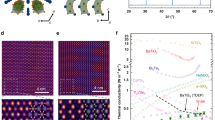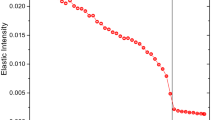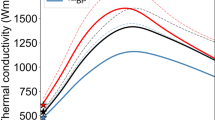Abstract
High pressure represents extreme environments and provides opportunities for materials discovery1,2,3,4,5,6,7,8. Thermal transport under high hydrostatic pressure has been investigated for more than 100 years and all measurements of crystals so far have indicated a monotonically increasing lattice thermal conductivity. Here we report in situ thermal transport measurements in the newly discovered semiconductor crystal boron arsenide, and observe an anomalous pressure dependence of the thermal conductivity. We use ultrafast optics, Raman spectroscopy and inelastic X-ray scattering measurements to examine the phonon bandstructure evolution of the optical and acoustic branches, as well as thermal conductivity under varied temperatures and pressures up to 32 gigapascals. Using atomistic theory, we attribute the anomalous high-pressure behaviour to competitive heat conduction channels from interactive high-order anharmonicity physics inherent to the unique phonon bandstructure. Our study verifies ab initio theory calculations and we show that the phonon dynamics—resulting from competing three-phonon and four-phonon scattering processes—are beyond those expected from classical models and seen in common materials. This work uses high-pressure spectroscopy combined with atomistic theory as a powerful approach to probe complex phonon physics and provide fundamental insights for understanding microscopic energy transport in materials of extreme properties.
This is a preview of subscription content, access via your institution
Access options
Access Nature and 54 other Nature Portfolio journals
Get Nature+, our best-value online-access subscription
$29.99 / 30 days
cancel any time
Subscribe to this journal
Receive 51 print issues and online access
$199.00 per year
only $3.90 per issue
Buy this article
- Purchase on Springer Link
- Instant access to full article PDF
Prices may be subject to local taxes which are calculated during checkout




Similar content being viewed by others
Data availability
The data that support the plots within this paper and findings of this study are available from the corresponding author upon request.
References
Zhang, L., Wang, Y., Lv, J. & Ma, Y. Materials discovery at high pressures. Nat. Rev. Mater. 2, 17005 (2017).
Konôpková, Z., McWilliams, R. S., Gómez-Pérez, N. & Goncharov, A. F. Direct measurement of thermal conductivity in solid iron at planetary core conditions. Nature 534, 99–101 (2016).
Knudson, M. D. et al. Direct observation of an abrupt insulator-to-metal transition in dense liquid deuterium. Science 348, 1455–1460 (2015).
Pozzo, M., Davies, C., Gubbins, D. & Alfe, D. Thermal and electrical conductivity of iron at Earth’s core conditions. Nature 485, 355–358 (2012).
Ma, Y. et al. Transparent dense sodium. Nature 458, 182–185 (2009).
Dubrovinsky, L. et al. The most incompressible metal osmium at static pressures above 750 gigapascals. Nature 525, 226–229 (2015).
Loubeyre, P., Occelli, F. & Dumas, P. Synchrotron infrared spectroscopic evidence of the probable transition to metal hydrogen. Nature 577, 631–635 (2020).
Fratanduono, D. E. et al. Establishing gold and platinum standards to 1 terapascal using shockless compression. Science 372, 1063–1068 (2021).
Bridgman, P. W. The Physics of High Pressure (MacMillan, 1931).
Lawson, A. On the high temperature heat conductivity of insulators. J. Phys. Chem. Solids 3, 155–156 (1957).
Rodionov, K. P. Problem of the effect of hydrostatic pressure on the thermal conductivity of insulators. Phys. Met. Metallogr. 6, 160–164 (1958).
Klemens, K. P. Pressure dependence of the thermal conductivity of non-metals. In Proc. Ninth Conf. Thermal Conductivity 533–534 (United States Atomic Energy Commission, 1969).
Slack, G. A. In Proc. Int Conf. Phonon Scattering in Solids 24 (Centre d’Etudes Nucleaires de Saclay, 1972).
Ziman, J. M. Electrons and Phonons: The Theory of Transport Phenomena in Solids (Oxford Univ. Press, 1960).
Leibfried, G. & Schlömann, E. Thermal conductivity of dielectric solids by a variational technique. Nachr. Akad. Wiss. Gött. Math.-Phys. Kl. 2A 23, 1366–1370 (1954).
Anderson, O. L. The Debye temperature of vitreous silica. J. Phys. Chem. Solids 12, 41–52 (1959).
Steigmeier, E. F. & Kudman, I. Thermal conductivity of III–V compounds at high temperatures. Phys. Rev. 132, 508–512 (1963).
Billard, D. & Cabannes, F. La conductivité thermique de réseau aux hautes températures. High Temp. High Press. 3, 201 (1971).
Wolf, G. H. & Jeanloz, R. Vibrational properties of model monatomic crystals under pressure. Phys. Rev. B 32, 7798–7810 (1985).
Slack, G. A. The thermal conductivity of nonmetallic crystals. Solid State Phys. 34, 1–71 (1979).
Gerlich, D. & Andersson, P. Temperature and pressure effects on the thermal conductivity and heat capacity of CsCl, CsBr and CsI. J. Phys. C: Solid State Phys. 15, 5211–5222 (1982).
Hakansson, B. & Andersson, P. Thermal conductivity and heat capacity of solid NaCl and NaI under pressure. J. Phys. Chem. Solids 47, 355–362 (1986).
Xiong, X., Ragasa, E. J., Chernatynskiy, A., Tang, D. & Phillpot, S. R. Lattice thermal conductivity of quartz at high pressure and temperature from the Boltzmann transport equation. J. Appl. Phys. 126, 215106 (2019).
Hsieh, W. P., Chen, B., Li, J., Keblinski, P. & Cahill, D. G. Pressure tuning of the thermal conductivity of the layered muscovite crystal. Phys. Rev. B 80, 180302 (2009).
Chen, B., Hsieh, W. P., Cahill, D. G., Trinkle, D. R. & Li, J. Thermal conductivity of compressed H2O to 22 GPa: a test of the Leibfried–Schlömann equation. Phys. Rev. B 83, 132301 (2011).
Ohta, K. et al. Lattice thermal conductivity of MgSiO3 perovskite and post-perovskite at the core–mantle boundary. Earth Planet. Sci. Lett. 349, 109–115 (2012).
Broido, D. A., Lindsay, L. & Ward, A. Thermal conductivity of diamond under extreme pressure: a first-principles study. Phys. Rev. B 86, 115203 (2012).
Dalton, D. A., Hsieh, W. P., Hohensee, G. T., Cahill, D. G. & Goncharov, A. F. Effect of mass disorder on the lattice thermal conductivity of MgO periclase under pressure. Sci. Rep. 3, 2400 (2013).
Mukhopadhyay, S. & Stewart, D. A. Polar effects on the thermal conductivity of cubic boron nitride under pressure. Phys. Rev. Lett. 113, 25901 (2014).
Sun, Z., Yuan, K., Zhang, X. & Tang, D. Pressure tuning of the thermal conductivity of gallium arsenide from first-principles calculations. Phys. Chem. Chem. Phys. 20, 30331–30339 (2018).
Lindsay, L., Broido, D. A. & Reinecke, T. L. First-principles determination of ultrahigh thermal conductivity of boron arsenide: a competitor for diamond? Phys. Rev. Lett. 111, 25901 (2013).
Kang, J. S., Li, M., Wu, H., Nguyen, H. & Hu, Y. Experimental observation of high thermal conductivity in boron arsenide. Science 361, 575–578 (2018).
Li, S. et al. High thermal conductivity in cubic boron arsenide crystals. Science 361, 579–581 (2018).
Tian, F. et al. Unusual high thermal conductivity in boron arsenide bulk crystals. Science 361, 582–585 (2018).
Kang, J. S. et al. Integration of boron arsenide cooling substrates into gallium nitride devices. Nat. Electron. 4, 416–423 (2021).
Cui, Y., Qin, Z., Wu, H., Li, M. & Hu, Y. Flexible thermal interface based on self-assembled boron arsenide for high-performance thermal management. Nat. Commun. 12, 1284 (2021).
Ravichandran, N. K. & Broido, D. Non-monotonic pressure dependence of the thermal conductivity of boron arsenide. Nat. Commun. 10, 827 (2019).
Kang, J. S., Li, M., Wu, H., Nguyen, H. & Hu, Y. Basic physical properties of cubic boron arsenide. Appl. Phys. Lett. 115, 122103 (2019).
Kang, J. S., Wu, H., Li, M. & Hu, Y. Intrinsic low thermal conductivity and phonon renormalization due to strong anharmonicity of single-crystal tin selenide. Nano Lett. 19, 4941–4948 (2019).
Maradudin, A. A. & Fein, A. E. Scattering of neutrons by an anharmonic crystal. Phys. Rev. 128, 2589–2608 (1962).
Lindsay, L. & Broido, D. A. Three-phonon phase space and lattice thermal conductivity in semiconductors. J. Phys. Condens. Matter 20, 165209 (2008).
Feng, T., Lindsay, L. & Ruan, X. Four-phonon scattering significantly reduces intrinsic thermal conductivity of solids. Phys. Rev. B 96, 161201 (2017).
Lindsay, L., Broido, D. A., Carrete, J., Mingo, N. & Reinecke, T. L. Anomalous pressure dependence of thermal conductivities of large mass ratio compounds. Phys. Rev. B 91, 121202 (2015).
Mao, H. K., Xu, J. A. & Bell, P. M. Calibration of the ruby pressure gauge to 800 kbar under quasi‐hydrostatic conditions. J. Geophys. Res. Solid Earth 91, 4673–4676 (1986).
Kunz, M. et al. A beamline for high-pressure studies at the Advanced Light Source with a superconducting bending magnet as the source. J. Synchrotron Rad. 12, 650–658 (2005).
Said, A. H. et al. High-energy-resolution inelastic X-ray scattering spectrometer at beamline 30-ID of the advanced photon source. J. Synchrotron Rad. 27, 827–835 (2020).
Toellner, T. S., Alatas, A. & Said, A. H. Six‐reflection meV‐monochromator for synchrotron radiation. J. Synchrotron Rad. 18, 605–611 (2011).
Rivers, M. et al. The COMPRES/GSECARS gas-loading system for diamond anvil cells at the Advanced Photon Source. High Press. Res. 28, 273–292 (2008).
Hu, Y., Zeng, L., Minnich, A. J., Dresselhaus, M. S. & Chen, G. Spectral mapping of thermal conductivity through nanoscale ballistic transport. Nat. Nanotechnol. 10, 701–706 (2015).
Kang, J. S., Ke, M. & Hu, Y. Ionic intercalation in two-dimensional van der Waals materials: in situ characterization and electrochemical control of the anisotropic thermal conductivity of black phosphorus. Nano Lett. 17, 1431–1438 (2017).
Kang, J. S., Wu, H. & Hu, Y. Thermal properties and phonon spectral characterization of synthetic boron phosphide for high thermal conductivity applications. Nano Lett. 17, 7507–7514 (2017).
Li, M., Kang, J. S. & Hu, Y. Anisotropic thermal conductivity measurement using a new asymmetric-beam time-domain thermoreflectance (AB-TDTR) method. Rev. Sci. Instrum. 89, 084901 (2018).
Li, M. et al. Anisotropic thermal boundary resistance across 2D black phosphorus: experiment and atomistic modeling of interfacial energy transport. Adv. Mater. 31, 1901021 (2019).
Thomsen, C., Grahn, H. T., Maris, H. J. & Tauc, J. Surface generation and detection of phonons by picosecond light pulses. Phys. Rev. B 34, 4129–4138 (1986).
Lin, H., Stoner, R. J., Maris, H. J. & Tauc, J. Phonon attenuation and velocity measurements in transparent materials by picosecond acoustic interferometry. J. Appl. Phys. 69, 3816–3822 (1991).
Wright, O. B. Thickness and sound velocity measurement in thin transparent films with laser picosecond acoustics. J. Appl. Phys. 71, 1617–1629 (1992).
Perrin, B., Rossignol, C., Bonello, B. & Jeannet, J. C. Interferometric detection in picosecond ultrasonics. Physica B 263, 571–573 (1999).
O’Hara, K. E., Hu, X. & Cahill, D. G. Characterization of nanostructured metal films by picosecond acoustics and interferometry. J. Appl. Phys. 90, 4852–4858 (2001).
Ma, W., Miao, T., Zhang, X., Kohno, M. & Takata, Y. Comprehensive study of thermal transport and coherent acoustic-phonon wave propagation in thin metal film–substrate by applying picosecond laser pump–probe method. J. Phys. Chem. C 119, 5152–5159 (2015).
Feng, T. & Ruan, X. Quantum mechanical prediction of four-phonon scattering rates and reduced thermal conductivity of solids. Phys. Rev. B 93, 045202 (2016); erratum 97, 079901 (2018).
Fan, H., Wu, H., Lindsay, L. & Hu, Y. Ab initio investigation of single-layer high thermal conductivity boron compounds. Phys. Rev. B 100, 85420 (2019).
Wu, H., Fan, H. & Hu, Y. Ab initio determination of ultrahigh thermal conductivity in ternary compounds. Phys. Rev. B 103, L041203 (2021).
Baroni, S., de Gironcoli, S., Dal Corso, A. & Giannozzi, P. Phonons and related crystal properties from density-functional perturbation theory. Rev. Mod. Phys. 73, 515–562 (2001).
Li, M., Dai, L. & Hu, Y. Machine learning for harnessing thermal energy: from materials discovery to system optimization. ACS Energy Lett. 7, 3204–3226 (2022).
Srivastava, G. P. The Physics of Phonons (Taylor & Francis, 1990).
Hohenberg, P. & Kohn, W. Inhomogeneous electron gas. Phys. Rev. 136, B864–B871 (1964).
Kohn, W. & Sham, L. J. Self-consistent equations including exchange and correlation effects. Phys. Rev. 140, A1133–A1138 (1965).
Giannozzi, P. et al. QUANTUM ESPRESSO: a modular and open-source software project for quantum simulations of materials. J. Phys. Condens. Matter 21, 395502 (2009).
Giannozzi, P. et al. Advanced capabilities for materials modelling with Quantum ESPRESSO. J. Phys. Condens. Matter 29, 465901 (2017).
Tadano, T., Gohda, Y. & Tsuneyuki, S. Anharmonic force constants extracted from first-principles molecular dynamics: applications to heat transfer simulations. J. Phys. Condens. Matter 26, 225402 (2014).
Acknowledgements
We thank B. Kalkan, K. Armstrong and B. Lavina for technical help and discussion. Y.H. acknowledges support from a CAREER Award from the National Science Foundation (NSF) under grant no. DMR-1753393, an Alfred P. Sloan Research Fellowship under grant no. FG-2019-11788, and the Vernroy Makoto Watanabe Excellence in Research Award. This work used computational and storage services associated with the Hoffman 2 Shared Cluster provided by UCLA Institute for Digital Research and Education’s Research Technology Group, and the Extreme Science and Engineering Discovery Environment (XSEDE), which is supported by National Science Foundation grant number ACI-1548562. This research used resources at the US Department of Energy (DOE) Office of Science user facility, including the Advanced Photon Source by Argonne National Laboratory under contract no. DE-AC02-06CH11357 and the Advanced Light Source by Lawrence Berkeley National Laboratory under contract no. DE-AC02-05CH1123.
Author information
Authors and Affiliations
Contributions
Y.H. proposed and directed the research. S.L., Z.Q. and M.L. performed the experiments. H.W. performed the theory calculations. M.K. helped with the XRD study. A.A. helped with the IXS study. A.K. helped with technical discussions. The manuscript was prepared by S.L., Z.Q., H.W., M.L. and Y.H. with input from all co-authors.
Corresponding author
Ethics declarations
Competing interests
The authors declare no competing interests.
Peer review
Peer review information
Nature thanks Yee Kan Koh and the other, anonymous, reviewer(s) for their contribution to the peer review of this work.
Additional information
Publisher’s note Springer Nature remains neutral with regard to jurisdictional claims in published maps and institutional affiliations.
Extended data figures and tables
Extended Data Fig. 1 Synchrotron X-ray diffraction (XRD) measurement of BAs and its pressure-dependent lattice constant.
a, Synchrotron XRD patterns of BAs measured at different pressures (~0–32.6 GPa), verifying the cubic phase of BAs under all high pressures without phase transition. b, Experimentally measured pressure-dependent lattice constant of BAs (circles), in comparison with the ab initio calculation (line).
Extended Data Fig. 2 Synchrotron single-crystal X-ray diffraction measurement.
Example diffraction image of BAs in which all peaks are indexed to the cubic phase.
Extended Data Fig. 3 Inelastic X-ray scattering (IXS) spectrum measurement of BAs crystal.
Shown in figure are scattering peaks that determine the phonon frequency for scattering vector Q at (3.5 2.5 2.5).
Extended Data Fig. 4 Brillouin scattering oscillation signals measured on a BAs sample.
Fast Fourier transform result of Brillouin scattering data (inset) determines the Brillouin frequency.
Rights and permissions
Springer Nature or its licensor (e.g. a society or other partner) holds exclusive rights to this article under a publishing agreement with the author(s) or other rightsholder(s); author self-archiving of the accepted manuscript version of this article is solely governed by the terms of such publishing agreement and applicable law.
About this article
Cite this article
Li, S., Qin, Z., Wu, H. et al. Anomalous thermal transport under high pressure in boron arsenide. Nature 612, 459–464 (2022). https://doi.org/10.1038/s41586-022-05381-x
Received:
Accepted:
Published:
Issue Date:
DOI: https://doi.org/10.1038/s41586-022-05381-x
This article is cited by
-
Vacancy-mediated anomalous phononic and electronic transport in defective half-Heusler ZrNiBi
Nature Communications (2023)
-
Thermal Management Performance of Epoxy Composites with Boron Nitride and Boron Phosphide Hybrid Fillers
Electronic Materials Letters (2023)
Comments
By submitting a comment you agree to abide by our Terms and Community Guidelines. If you find something abusive or that does not comply with our terms or guidelines please flag it as inappropriate.



